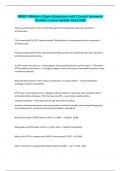NR601-Midterm Exam-Questions with Correct Answers/
Verified/ Latest Update 2024/2025
FVC low and FEV1/FVC ratio normal? What pattern of lung disease does this represent? -
✔✔restrictive
FVC normal and FEV1/FVC ratio decreased? What pattern of lung disease does this represent? -
✔✔obstructive
FVC decreased and FEV1/FVC ratio decreased? What pattern of lung disease does this represent? -
✔✔obstructive and restrictive
If a PFT results restriction or a mixed pattern, what should be done to confirm type? - ✔✔another
PFT (inhalation of elements, i.e. nitrogen, oxygen, helium, and carbon monoxide) to measure levels
of elements exhaled)
What should be done if a PFT results an obstruction or mixed pattern? - ✔✔bronchodilator
challenge; indicates reversibility
If PFTs are normal and exercise or allergen induced asthma is suspected, what should be done? -
✔✔methacholine challenge + FEV1 decrease by 20%; - result helps exclude asthma
mannitol inhalation: + FEV1 decrease by 15% and confirms asthma
eucapnic voluntary hyperpnea: spirometry before and after 6 minutes of sex induced hyperpnea.
Use to determine if use of pre-exercise bronchodilator is beneficial
What GOLD grade of COPD yields an FEV1 >/= 80%? - ✔✔gold 1 (mild)
What grade of COPD yields an FEV1 >/=50%, <80% - ✔✔gold 2 (moderate)
What is the FEV1 in a patient with GOLD 4 (very severe) COPD? - ✔✔<30%
What is the FEV1 in a patient with GOLD 3 (severe) COPD? - ✔✔>/= 30%, <50%
,What are the 2 most common risk factors for lung cancer? - ✔✔advancing age, smoke exposure
What are the 2 most common types of lung cancer? Which is most common? - ✔✔small cell and non
small cell; NSCLC
What is the recommendation for lung cancer screening as per the USPTF? - ✔✔20-year pack
smoking history AND currently smoke or quit within the last 15 years AND between 50-80 years
What components does the ASCVD Risk Calculator measure? - ✔✔BP, total cholesterol, HDL (also
considers diabetic, smoker, and treatment for HTN)
What is the most common predictor of CVD and cardiac risk in older adults? - ✔✔widening pulse
pressure
What are the nonpharmacological hypertension therapies? - ✔✔wt. loss, reduced NA, aerobics,
dynamic resistance exercise, dash diet, increased K+. isometric resistance, moderation in alcohol
SSNRIs, NSAIDs, and estrogen increase blood pressure (T/F). - ✔✔T
What findings would be present on an ECG of someone with a-fib? - ✔✔absence of p waves, fine
fibrillatory waves between QRS complexes, tachycardia
What are the most significant risk factor for DM II? - ✔✔age, obesity, hypertension, sedentary life
style, and family history
Fatigue, vision changes, dry mouth, and recurrent candida infections may indicate DMII. (T/F). - ✔✔T
What initial tests should be ordered when DM II is suspected? - ✔✔BP, non-fasting glucose, lipid
panel, Hgb A1C
What is the first line agent for treating type II DM? - ✔✔Metformin: <60, pre-diabetes, BMI > 35, hx
gestational DM, A1C <9%
,At what A1C would insulin therapy be considered for a diabetic patient? - ✔✔11% or failure of two
or more oral agents
What is the typical target for A1C in patients with DM? - ✔✔less than 7%
What is the recommendation for retinal exam and urine microalbumin/creatinine ratio for a patient
who has just been diagnosed with diabetes? - ✔✔at diagnosis and then yearly
Which tests should be done for a patient with diabetes at least every 6 months? - ✔✔blood
chemistries and renal function
How often does the A1C need to be drawn for a patient with DM? - ✔✔every 3 mths or every 6 if
well-controlled
How often should a complete foot exam with monofilament be done for a patient with DM be done?
- ✔✔every year
When should patients without risk factors for DM begin screening A1C? - ✔✔45
What are the initial test to be done for suspected thyroid disease? - ✔✔TSH, if low free T4 (no
routine screening if no risk factors)
What risk factors indicate the need to routinely screen for thyroid dysfunction? - ✔✔co-existing
autoimmune disorders, first degree relative with autoimmune disease, history of neck radiation,
abnormal thyroid examination, co-existing psychiatric disorders
A single test can diagnose thyroid disorder. (T/F) - ✔✔F; a combo of test and clinical symptoms
should be evaluated
Explain the TSH, T4 and T3 in hyperthyroidism. - ✔✔low high/normal, high/normal
Explain the TSH, T4 and T3 in subclinical hyperthyroidism. - ✔✔low, normal, normal
, Explain the TSH, T4 and T3 in secondary thyroid problem (pituitary cause). - ✔✔low, low/normal,
low/normal
Explain the TSH, T4 and T3 in thyroid hormone resistance (Refetoff syndrome)? - ✔✔normal, high,
high
Explain the TSH, T4 and T3 in subclinical hypothyroidism? - ✔✔High, normal, normal
Explain the TSH, T4 and T3 in hypothyroidism? - ✔✔High, low, low normal
What types of drugs are useful in the treatment of tachycardia and other hyperadrenergic symptoms
from thyrotoxicosis of any etiology? - ✔✔betablocker
What drug class is useful for treating clients with subacute or silent thyroiditis? - ✔✔NSAIDs
Useful in the management of thyrotoxicosis due to overproduction of thyroid hormone from
autonomous thyroid nodules and in Graves disease. - ✔✔antithyroid drugs
Preferred therapeutic option in clients who have thyrotoxicosis due to overproduction of thyroid
hormone. - ✔✔radioactive iodine
The fastest way to achieve euthyroid, but because of increased operative risk in older clients, it is
reserved for select cases, such as concomitant thyroid cancer or severe ophthalmopathy. -
✔✔thyroidectomy
Which type of thyroid disorder may be asymptomatic in older adults? - ✔✔hyperthyroidism
What are the symptoms of hyperthyroidism in the older adult? - ✔✔edema, unexplained wt. loss,
dyspnea on exertion, tachycardia, atrial fibrillation
What are the risks of iatrogenic due to overcorrection of hypothyroidism? - ✔✔a fib and
osteoporosis (especially in post menopausal women




